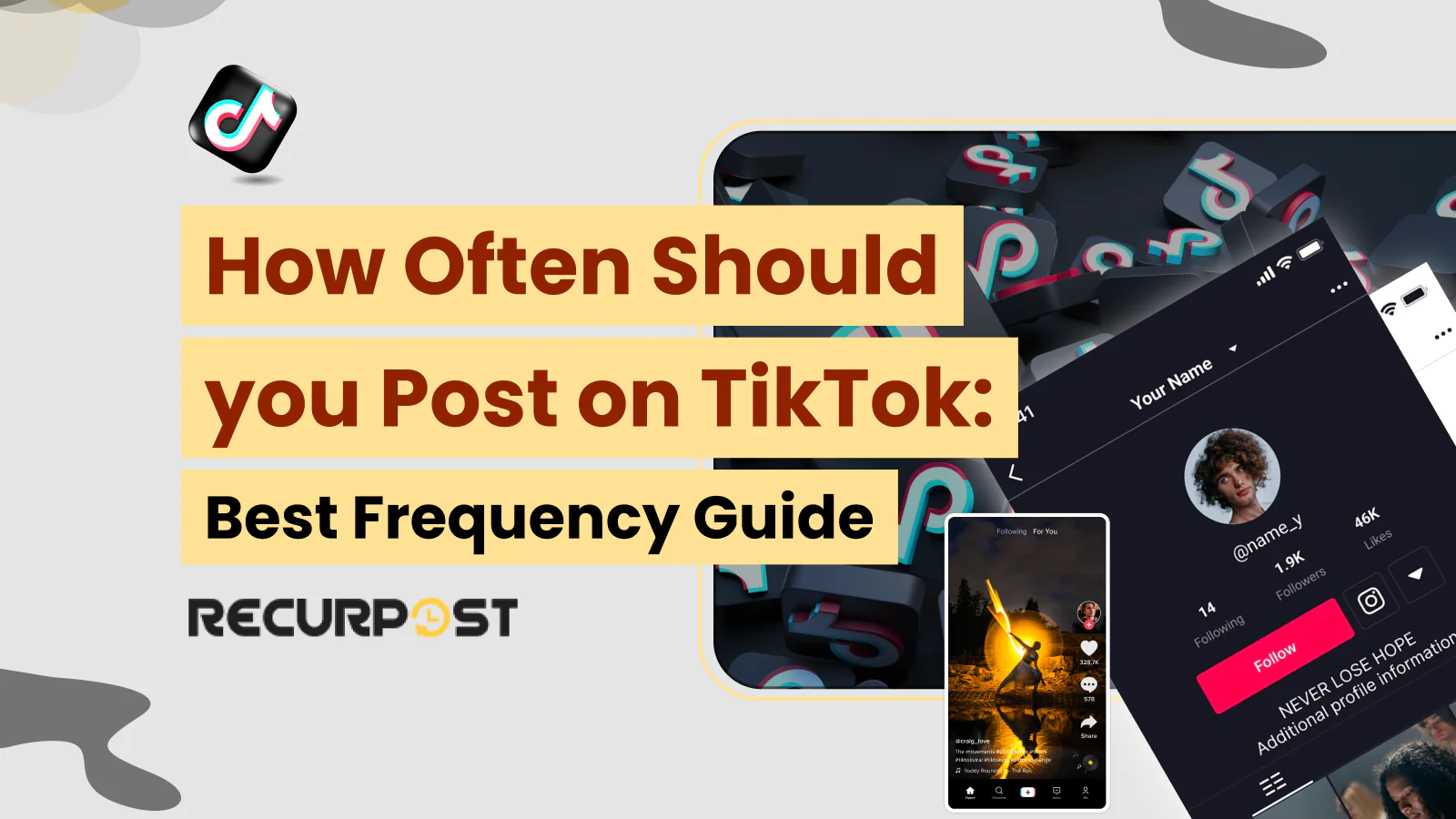Spending hours creating TikTok videos with barely any views? You might be posting at the wrong time. On a fast-moving platform like TikTok, timing and posting frequency can make or break your reach. If your videos drop outside your audience’s peak engagement times, you’re likely missing out on huge visibility.
Instead of guessing, dig into your TikTok analytics dashboard. It helps you uncover your audience’s activity patterns so you can adjust your TikTok content calendar. Finding the right rhythm, how many times a day, what days of the week, and how consistently can unlock serious growth.
This guide breaks down exactly how often should you post on TikTok, what the TikTok algorithm recommends, and how to align your content schedule with your creative workflow. Whether you’re aiming for 3-5 times weekly or testing out 1-4 daily posts, you’ll walk away with a clear plan built for 2025’s TikTok scene.
Why Posting Frequency Has an Impact on TikTok
Posting frequency on TikTok isn’t just a best practice: it’s a major driver of visibility. TikTok’s environment moves fast, and your posting rhythm directly affects how far your content spreads. Compared to other platforms, TikTok rewards consistency more than volume.
How consistency affects TikTok’s algorithm
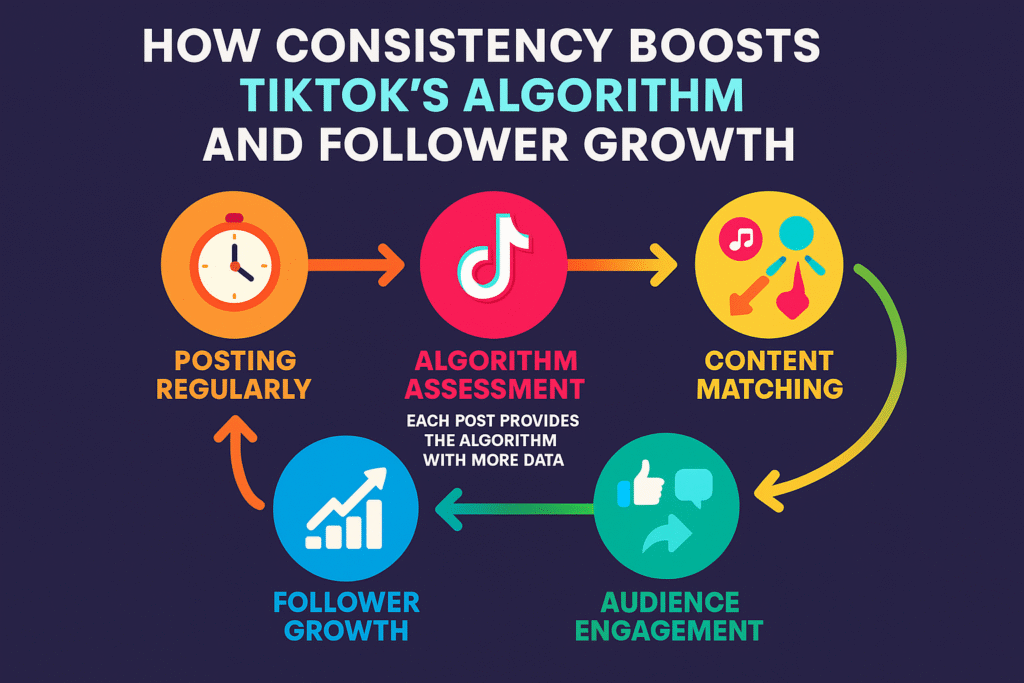
TikTok’s algorithm acts as a smart content matchmaker. It analyzes how you post to link your videos with people who might like them. It serves as your online brand rep; the more you post, the better it gets your content style and what your audience likes.
You can’t deny that the algorithm likes active accounts. When you stick to a regular posting plan, TikTok sees your account as trustworthy and worth pushing. Studies show TikTok’s algorithms favor creators who post often. This boost turns into more views, which then leads to more engagement and follower growth.
What’s more, every video you upload gives the algorithm a new chance to assess your content. When you post often, you give TikTok more info to work with, helping it get a better grasp of:
- The style and format you prefer for your content
- How your audience interacts with your posts
- Which viewers are most likely to enjoy what you create
Our research reveals that business accounts maintaining regular posting schedules achieve 47% faster follower growth and 3x more profile visits than inconsistent posters. This correlation between consistency and growth demonstrates the necessity of establishing steady posting rhythms within TikTok strategies.
Unlock the Best Time to Post on TikTok
Post smart, not just often, let AI guide your timing.
⭐ 4.6/5 average user rating (based on 2,000+ reviews)
How often you post affects visibility and engagement
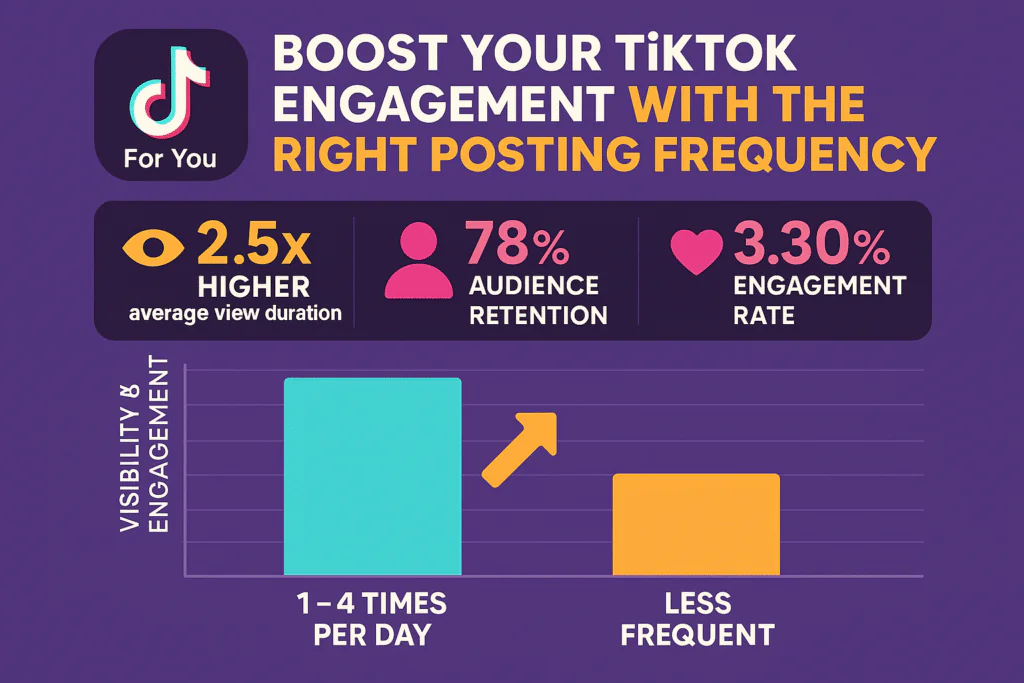
Your TikTok posting schedule plays a huge role in how visible your videos become. Post too little and you vanish; post too often and you might burn out. The trick lies in finding a frequency that keeps your audience interested without overwhelming them.
How often should you post on TikTok? Regular activity directly boosts your shot at appearing on the For You Page (FYP)—TikTok’s biggest discovery engine. Consistent posters enjoy:
- 2.5x higher average view duration
- 78% better audience retention
- Better odds of landing on For You pages
Business accounts that post get an average of 17,523 views per video, showing the clear benefits of keeping a steady posting rhythm. Also, regular posting achieves an engagement rate of 3.30%, while posting here and there can’t match this performance.
Posting habits vary significantly across the platform. Typical brands publish approximately 1.9 videos weekly or eight monthly. Meanwhile, the top 25% of active brands share videos at least four times weekly on average. This divergence from TikTok’s official recommendation of 1-4 daily posts highlights the gap between ideal and practical posting schedules.
Reliable posting builds trust. Followers learn when to expect new content, which strengthens brand perception and triggers engagement signals. Those who post 1–4 times a day report 56% better interaction rates.
And TikTok doesn’t wait. It judges posts within the first few hours. Videos that quickly gain views, comments, and likes are more likely to be promoted further. Posting regularly keeps feeding the TikTok algorithm, increasing your chances of being seen.
To grow your presence, mix quality with rhythm. Choose a content calendar that aligns with your energy, audience activity, and TikTok growth goals.
TikTok’s Recommendations vs. Real-World Success
What TikTok suggests versus what works shows an interesting gap in how the platform operates. This difference matters when creating a content plan that gets results, not just following general tips.
How often TikTok says to post
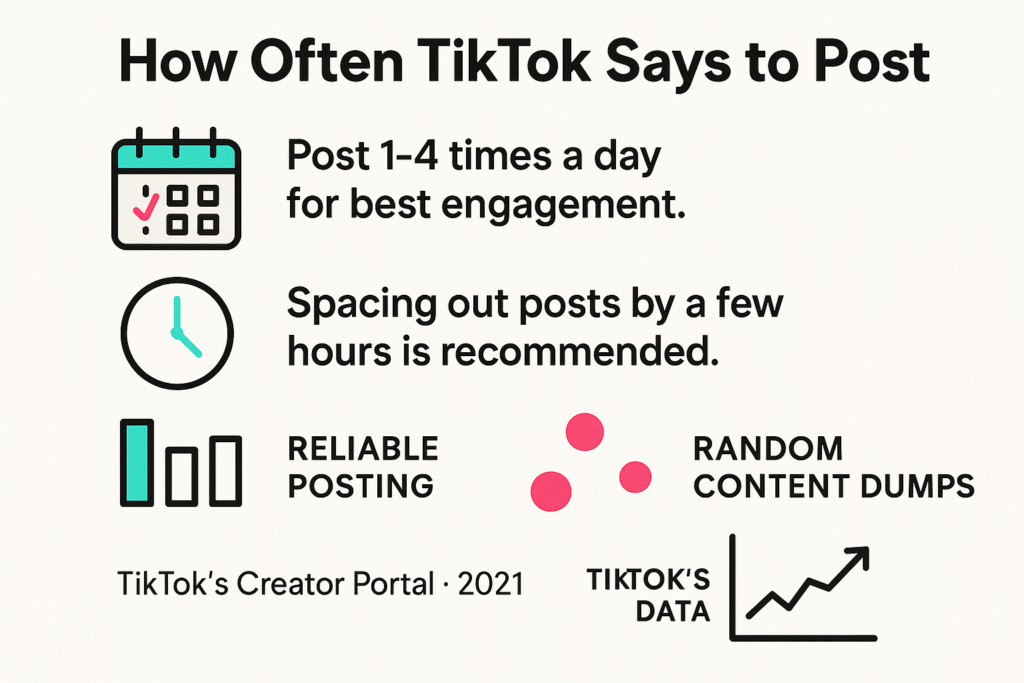
According to the TikTok Creator Portal, creators should post 1-4 times daily. This cadence supports TikTok’s model, which thrives on constant content to keep users scrolling. Their data shows that this posting frequency boosts engagement rates across most business accounts.
But it’s not just about volume. The Creator Portal emphasizes consistent timing over random bursts. TikTok advises posting hours apart, not all at once. And these suggestions haven’t really changed since 2021, even though the way people use TikTok has.
Even so, these official guidelines haven’t changed much since 2021, despite big shifts in how people use and watch content.
This makes us wonder: do these suggestions still match what works on the platform in 2025?
What top creators are doing
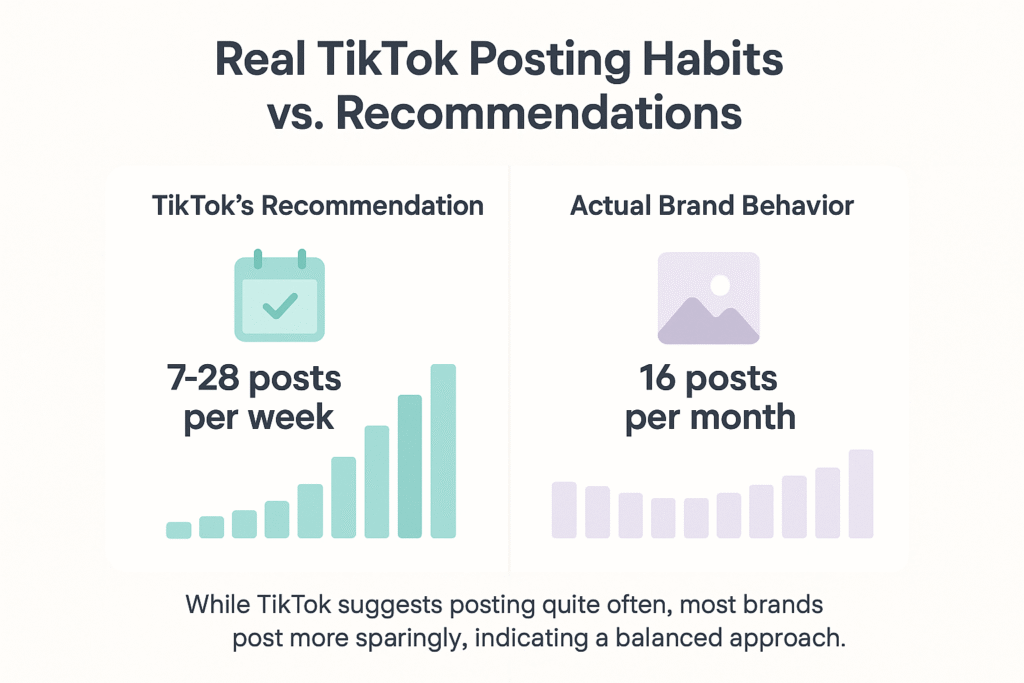
Real posting habits are quite different from what TikTok suggests. Industry research shows that the average brand puts up about 16 posts per month every other day. Another study found brands posting 1.75 times per week on average.
Even the most active brands publish content approximately five times weekly, substantially below TikTok’s recommended 7-28 weekly posts. This real-world pattern demonstrates successful accounts balance visibility requirements with resource management.
How often accounts post changes quite a bit based on the type of account and how many followers they have:
| Account Type | Typical Posting Frequency | Primary Motivation |
| Small Creators (0-10K) | 3-5 times per week | Building audience, testing content |
| Growing Creators (10K-100K) | 1-2 times daily | Increasing visibility |
| Large Creators (100K-1M) | 2-4 times daily | Maintaining engagement |
| Viral Creators (1M+) | 3-5 times daily | Maximizing reach |
| Brands & Businesses | 4-6 times per week | Balancing quality with strategy |
The data reveals that posting beyond 5 times daily yields diminishing returns. This indicates a threshold beyond which additional content provides minimal value and potentially harms performance.
Creators experiencing consistent growth maintain 4-6 posts weekly, demonstrating sustained consistency outperforms raw volume for long-term success. A former TikTok employee recommends posting every 2-3 days as an initial approach, emphasizing that content creation should remain enjoyable rather than burdensome.
Companies specifically achieve optimal results with 2-3 strategically planned daily posts supported by data analysis. The real answer to how often you should post on TikTok is? It depends on your niche, your stamina, and your goals, but real data beats generic rules.
Best Days & Times to Post on TikTok in 2025

Different days of the week see different engagement levels, with posting times during the day varying significantly compared to other social media platfo rms. Understanding the best post times to post on TikTok is essential for maximizing your content’s reach.
| Day of the Week | Recommended Frequency | Best Posting Times | Why? |
| Monday | 1-2 posts | 6-10 PM | Users are busy but scroll at night. |
| Tuesday | 1-2 posts | 12-3 PM, 6-10 PM | Afternoon & early evening engagement increases. |
| Wednesday | 1-2 posts | 6-10 PM | Midweek slump = more night scrolling. |
| Thursday | 2-3 posts | 12-3 PM, 6-10 PM | Weekend anticipation boosts engagement. |
| Friday | 2-4 posts | 6-10 PM | High engagement before the weekend. |
| Saturday | 2-4 posts | 10 AM-2 PM, 6-10 PM | Prime weekend scrolling time. |
| Sunday | 1-3 posts | 10 AM-2 PM, 6-10 PM | Last chance before the new week starts. |
Optimize your TikTok content strategy by syncing posts with high-traffic periods. These time slots offer better reach, especially when combined with consistent posting frequency.
How often should you post on TikTok by Industry?
Determining how often you should post on TikTok for business is important; informational content doesn’t require daily posts but needs consistent scheduling. Your TikTok post frequency should align with your industry trends, target audience, and content sustainability.
Different industries have different posting frequency needs. Here’s a guide for you:
| Industry Type | Recommended Frequency | Why? |
| Entertainment (Comedy, Skits) | 2-4 times per day | Fast-moving trends require frequent content. |
| Education & How-To Content | 3-5 times per week | In-depth content provides lasting value. |
| Fashion & Beauty | 4-7 times per week | Visual appeal and trends drive engagement. |
| Food & Recipes | 3-5 times per week | Step-by-step videos need quality production. |
| Fitness & Health | 4-6 times per week | Daily motivation & workouts keep users engaged. |
| Business & Social Media Marketing | 2-4 times per week | Informational content doesn’t require daily posts. |
| Tech & Gadgets | 3-5 times per week | Product reviews need consistency & quality. |
| E-commerce & Brands | 4-7 times per week | Frequent content drives sales and awareness. |
How to Figure Out Your Best Posting Schedule
Your perfect TikTok posting schedule depends on your goals and capacity. One-size advice like “post daily” isn’t right for everyone. Strategy should guide how often you post, not assumptions. Research says most viewers expect 1–2 posts a day, but your actual cadence should reflect your niche and creative limits.
Choose clear aims for your TikTok account
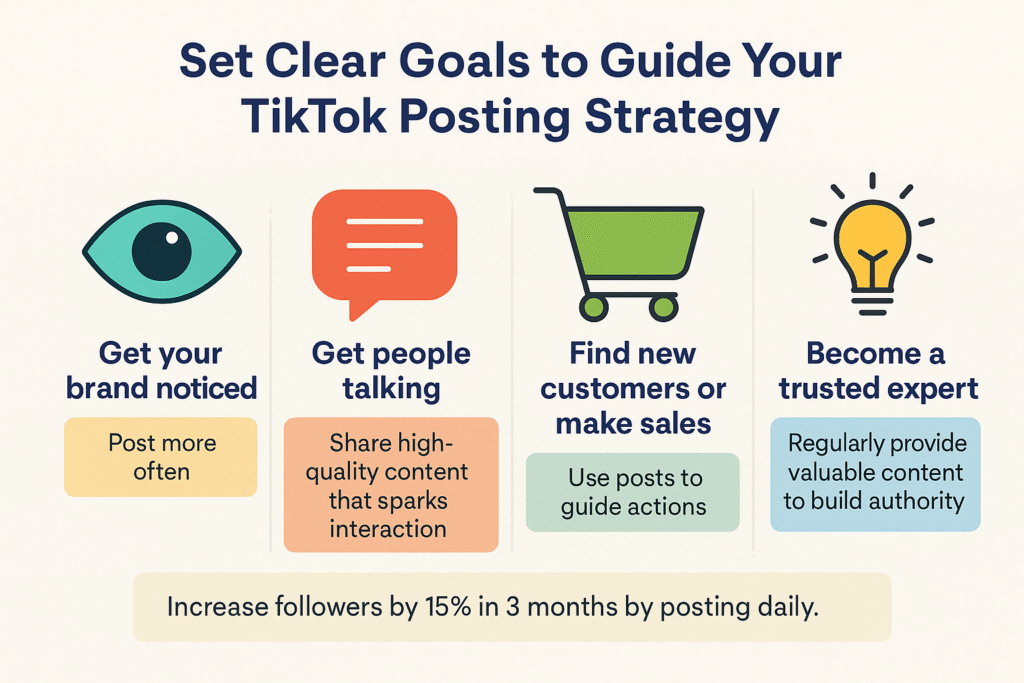
To answer how often should you post on TikTok, think about what you’re aiming for. Your posting rhythm should match your mission:
- Get your brand noticed – You’ll need to post more often to get seen by more people
- Get people talking – Focus on great content that makes people want to interact
- Find new customers or make sales – Post to guide users to take action
- Become a trusted expert – Share valuable content on a regular basis
Set SMART goals: Clear, Countable, Doable, Fitting, and Deadline-driven. For example, don’t just say you want “more followers”. Instead, aim for something like “boost follower numbers by 15% in the next three months by posting every day”.
Sync your posting speed with your content style
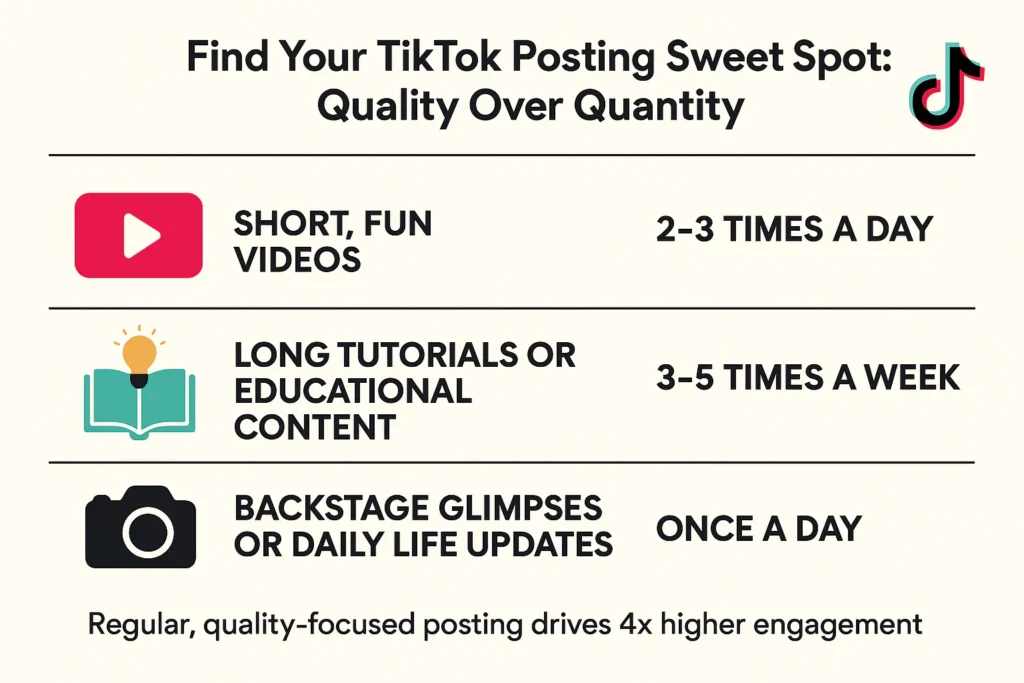
Your content type significantly affects how often you should post. Different content types have natural consumption limits:
- Short, fun videos can be shared more often (2-3 times a day)
- Long tutorials or educational stuff work better when posted less (3-5 times a week)
- Backstage glimpses or daily life updates can keep a steady pace (once a day)
Overall, your creative ability has a big impact on how often you can post. If making top-notch videos takes a lot of time and resources, it’s better to focus on fewer well-made posts instead of cutting corners to post more often. Industry data shows that brands should make as much content as they can without lowering their quality.
To find your sweet spot, try out different posting schedules over a few weeks. During this test period, keep a close eye on how well your TikTok posts are doing to spot trends. You’ll see that after a certain point, more posts don’t lead to much more engagement.
TikTok’s Business Marketing Hub research shows that accounts with regular posting schedules have an influence on engagement rates that are 4 times higher compared to those that post.
Understanding Your Audience’s Behavior
TikTok’s success requires understanding when and how your viewers engage with your content. Even great videos can flop if you post them when your followers aren’t online. TikTok’s built-in features can help uncover these key patterns.
Use TikTok analytics to track follower activity
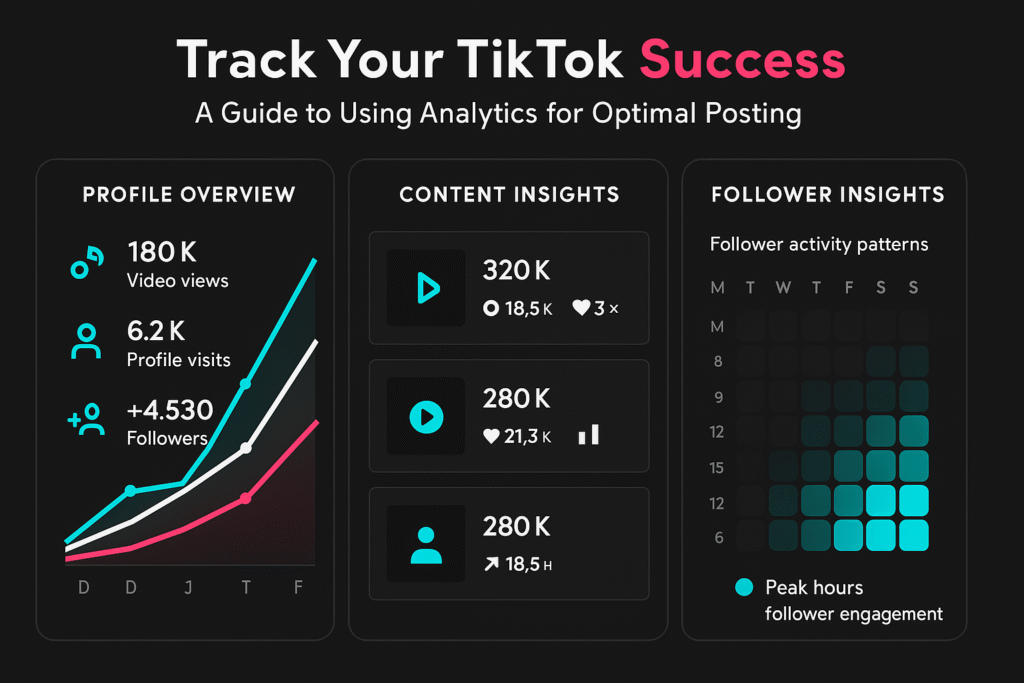
Access to these insights starts by switching to a TikTok Pro or Business account—a free upgrade in your profile settings. Once active, you can explore three core areas of analytics:
Profile Overview: This snapshot shows how your account is doing. It includes data on video views, profile visits, and how fast you’re gaining followers over time. Keeping an eye on these trends helps you see how often your post relates to your account’s overall performance.
Content Insights: This part breaks down how well each of your videos does. It shows which types of content get people to engage more. Take a good look at videos that do better than usual, and when you post them often gives you hints about the best times to post.
Follower Insights: This area is the most useful for figuring out when to post. It gives you detailed info about who your followers are and when they’re active. TikTok shows you the busiest hours for your followers each day of the week. It’s like a map that shows when people are most likely to see what you post.
Accounts that align posts with follower insights and platform peaks gain up to 32% higher engagement rates than those posting randomly. Analytics also reveals that TikTok users open the app at least 8 times a day, with engagement shifting by age and behavior.
Use this data to guide smarter content planning, not guesswork. When your TikTok posting schedule matches audience activity, your videos get more reach and better results.
Find out when your audience is most engaged
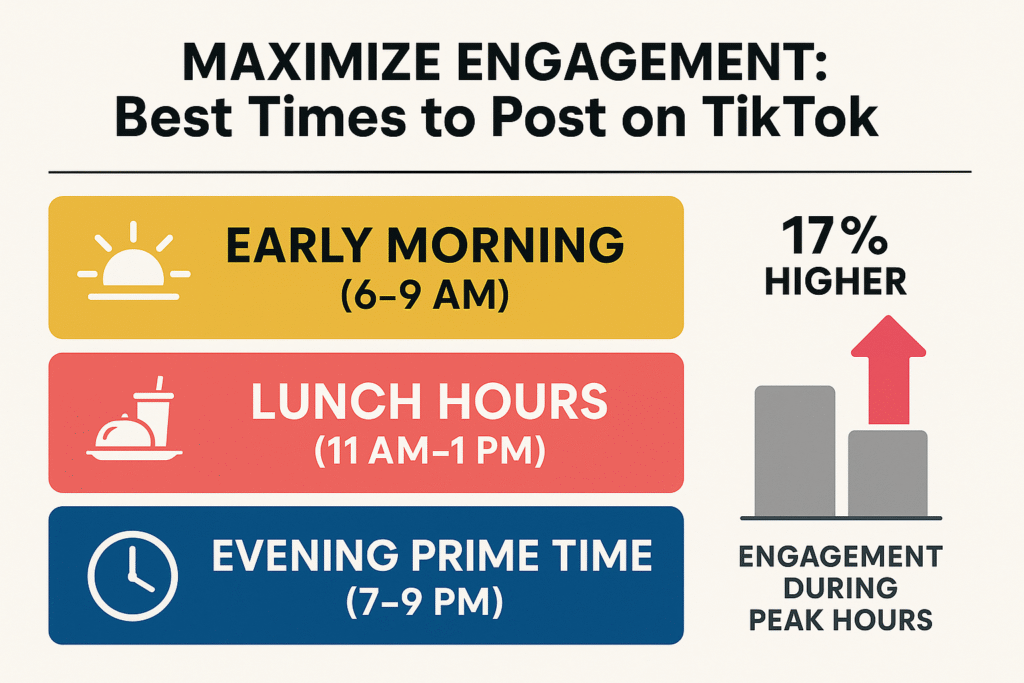
Once you’ve gathered enough analytics data (at least 2-3 weeks) clear patterns will show up. These patterns reveal 3-5 key posting times each day when you have the best chance to engage your audience.
TikTok engagement patterns are quite different from other social media platforms. While the so-called “best time to post on TikTok” changes for each account, studies show certain times do better than others:
- Early morning (6-9 AM): Reaches people during their morning routines
- Lunch hours (11 AM-1 PM): Connects with users during their midday breaks
- Evening prime time (7-9 PM): Hits the highest overall platform activity
Posts made during these time slots have an influence on engagement rates that are about 17% higher compared to posts made outside peak hours.
Also, the day of the week when you post has a big impact on how well your content does. Unlike what many think, posts on weekdays often do better than those on weekends for lots of accounts. Business content tends to get more engagement from Tuesday to Thursday.
To find out when it’s best for you to post:
- Keep track of how much engagement you get at different times over a few weeks.
- Look for times when your content always does well.
- Make a chart that shows when your audience is most active.
- Change your posting schedule to match these times.
Testing and Improving Your Schedule
Smart creators use data-driven A/B testing to refine their posting schedule on TikTok. Once you’ve spotted audience behavior trends, testing takes out the guesswork and turns it into real results.
How to do A/B tests on posting frequency
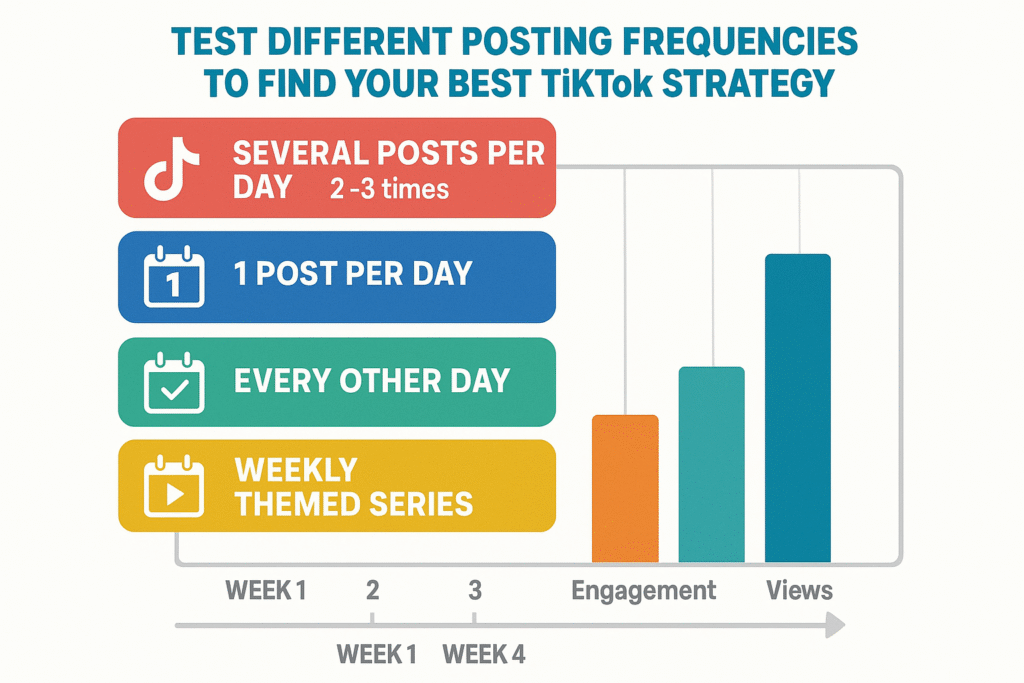
A/B testing on TikTok requires a structured approach. Start by testing different posting frequencies:
- Several posts each day (2-3 times)
- One post every day
- Content every other day
- Weekly themed series
Keep an eye on how each approach affects key metrics for 2-4 weeks. This test period gives enough data and includes both weekdays and weekends to produce thorough results.
To get more accurate results, try different posting schedules for each type of content. Educational tutorials might do better or worse than dance videos, so they need their own testing schedules.
Also, switch between posting when your audience is most active and trying out less common times. Sometimes, the lower competition during quiet hours can lead to unexpected outcomes.
TikTok’s scheduling tool lets you line up posts up to 10 days ahead, making it easier to test. It’s best to run these tests so you don’t throw off your followers with weird posting patterns.
At the same time, try posting at different times to find the best slots.
How to measure success
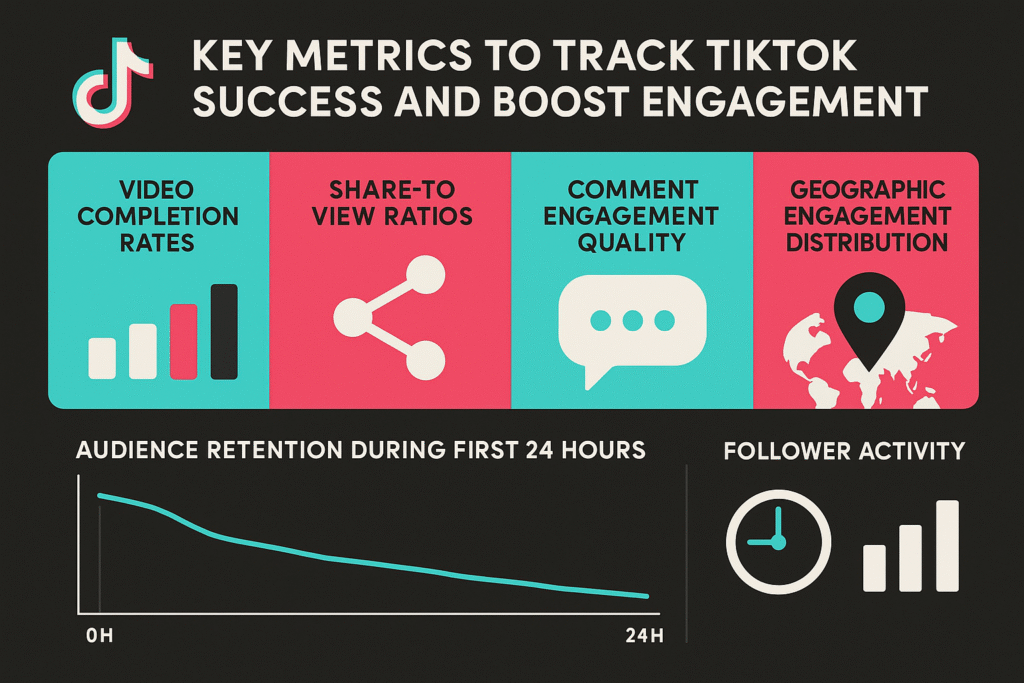
Tracking the right numbers makes sure your tests give you useful results. TikTok’s system puts a lot of weight on these key stats:
- Video completion rates (shoot for over 60%)
- Share-to-view ratios (shows content value)
- Comment engagement quality (not just numbers)
- Geographic engagement distribution (audience reach)
Keep an eye on video performance in the crucial first 24 hours after posting. Research shows TikTok videos get 68% of their total views during this time. Also, check audience retention graphs to spot when viewers lose interest in specific content types.
The Follower Activity tab in analytics reveals daily engagement peaks unique to your audience. Posting during these windows improves results by up to 30% versus off-peak hours.
In addition to built-in analytics, keep an eye on these key metrics:
- Completion rates for different types of videos
- Graphs showing how long viewers stick around
- Times when engagement peaks
- Topics that get people sharing
These numbers show what content clicks with your audience and how often to post without overwhelming your followers. So, tweak your schedule based on what the data tells you, not on general advice.
And remember: A/B testing should be continuous. TikTok’s algorithm shifts often. Staying visible means staying flexible. Record your test cycles so you build a valuable playbook as trends evolve through 2025.
Using the RecurPost Scheduling Tool to Stay Consistent
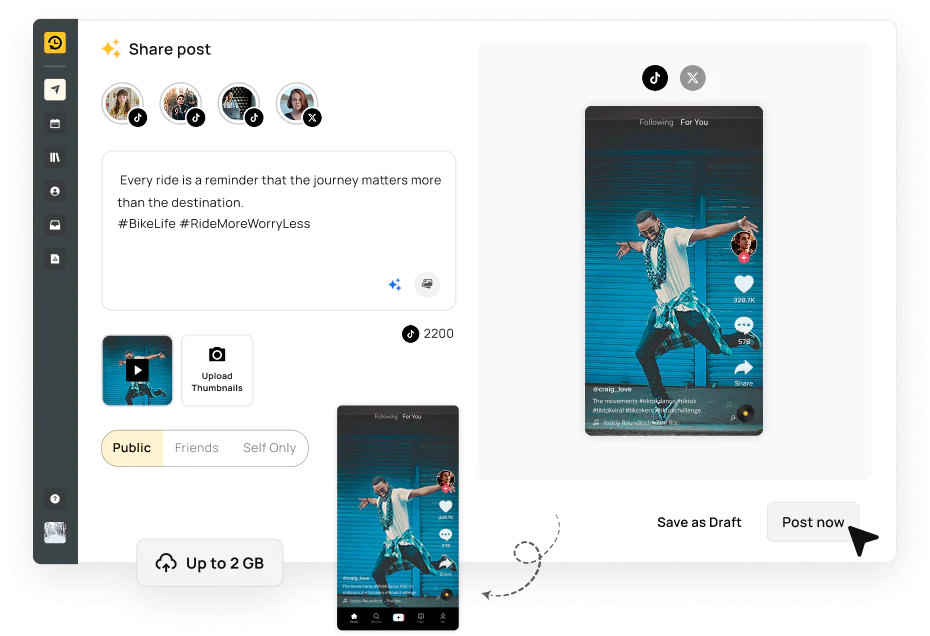
TikTok scheduling tools eliminate the need for manual posting by letting you plan content in advance. RecurPost shines among these tools thanks to features tailored specifically for TikTok creators:
- When to post based on your audience’s peak activity times
- Scheduling in bulk lets you upload several videos at once
- Big video files up to 2GB with custom thumbnails supported
- Reusing content helps give successful videos a fresh spin
The platform’s top feature is identifying peak engagement periods. It analyzes when your audience is online and suggests ideal posting slots. This aligns perfectly with earlier A/B testing strategies discussed.
While TikTok’s built-in scheduler limits you to 10 days, RecurPost goes beyond. If you manage multiple accounts, this tool simplifies the process from a single dashboard, helping creators stay consistent without burning out.
How to Make a TikTok Content Calendar with RecurPost
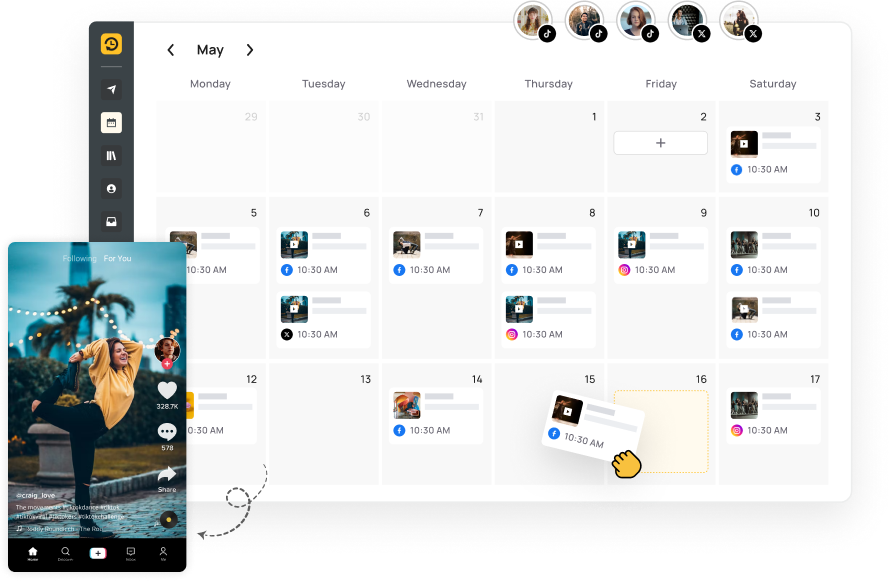
A TikTok content calendar is the backbone of your posting plan, helping you map out videos, themes, and campaigns for a consistent flow. Using RecurPost simplifies this process and strengthens your social media strategy.
Here’s how RecurPost helps build a strategic TikTok content calendar:
1. Getting your content ready ahead of time to stay on top of things, even when markets change or new trends pop up.
2. Figuring out how often should you post on TikTok (most brands do well with 3-5 posts each week).
3. Grouping your content by themes keeps your audience interested.
4. Setting up posts for the times when your followers are most likely to engage.
A well-structured calendar inside RecurPost offers a high-level view of your content pipeline and planning efforts. It also becomes a shared workspace when working with teams, keeping everything aligned and on schedule.
Conclusion
Maintain TikTok success by batch-creating videos, scheduling posts smartly, and tracking trend shifts. Whether you’re a brand or individual, use insights from TikTok data to guide your posting plan—not guesswork.
Review where your audience is located and post at peak times to boost engagement. These choices help your videos land on the For You Page (FYP), which increases visibility and drives faster TikTok growth.
Publishing strong content consistently beats posting just for the sake of it. Test different time slots and refine how often should you post on TikTok to uncover what works best for your audience.
You can also take a look at how to get more followers on TikTok.
Frequently Asked Questions
1. How can audience demographics affect my TikTok posting frequency?
Audience behavior directly impacts your TikTok posting frequency. Knowing when your followers are most active helps you fine-tune your posting strategy for maximum engagement. Regularly check analytics to adjust your timing and match their viewing patterns.
2. Can I post too often on TikTok?
Yes. Posting too frequently can overwhelm followers, especially if content quality drops. The ideal TikTok posting frequency balances consistency with creativity. Focus on a sustainable posting plan that doesn’t compromise video quality.
3. How do I create a TikTok strategy that complements my posting frequency?
A strong TikTok strategy aligns with your posting frequency. Stick to regular, high-quality uploads that reflect your brand. Plan content in advance, using seasonal trends and audience interests to keep videos relevant.
4. Should I post multiple times a day or once a day on TikTok?
The answer depends on your goals and resources. If you can consistently create high-quality content without compromising your brand’s message, posting multiple times a day can work. However, if you’re focused on maintaining top-tier content, posting once a day or a few times a week might be more effective for you.
5. Can TikTok’s algorithm affect my posting frequency?
Absolutely. The TikTok algorithm rewards consistent, engaging content. If your posts trigger likes, comments, or replays, increasing your posting frequency may help, but never at the cost of quality. Prioritize value over volume.
6. How can I adjust my TikTok posting frequency based on performance?
Use posting performance metrics, views, shares, and engagement rates to refine your strategy. If results drop, tweak your timing or frequency. Monitoring this data ensures your posting schedule matches what your audience prefers.

Shalini Nagar is an experienced content writer with a proven track record of creating diverse and engaging content across various formats. With years of expertise in crafting blogs, articles, she excels at delivering compelling narratives tailored to different audiences.

